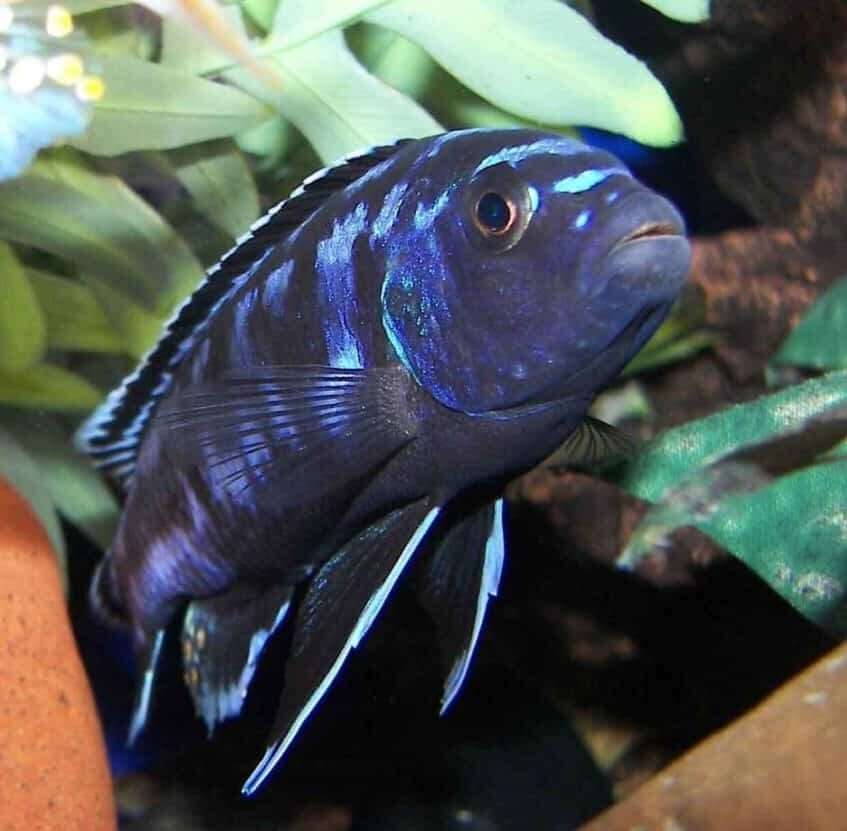
Size
Johanni Cichlids can reach a maximum length of 4 inches.
Physical Characteristics and Behavior
The body of Pseudotropheus johannii is long, slender, and lateral compression is moderate. Melanochromis auratus is similar in appearance in the body, nose, and forehead. Smallmouth, lower jaw is shorter than the top. Young animals and females are orange-yellow with two longitudinal black stripes. The anal fin rim and initial pelvic fin rays are white. Sharp dorsal fin with a stripe of dark blue. Black and blue men. One is above the eyes, one is between. From the head to the tailfin, this band is present. A second longitudinal stripe is located above the pectoral fins and behind the gill cover. A band is made up of light blue spots near the dorsal fin’s base. Dorsal and anal fin edges, as well as the first pelvic fin rays, are white to light blue.
Care and Requirements in Captivity

- Water Conditions
It can endure temperatures of between 72 and 82 °F (22 to 28 °C). It ranges from 10 to 20. They are only kept with aggressive African cichlids, ranging from one male to two or more females.
- Tank Size
Try to replicate the deep and vast lake environment as much as you can when building a house for mbuna. 75 gallons (48 inches by 18 inches by 21 inches) is the suggested tank size for a group of 6–8 adult Johanni cichlid fish. You can choose somewhat smaller tanks as long as they have a length of at least 48 inches so they can draw their own territorial lines.
You would need a larger tank of 100 gallons or more if you intended to mix this species with other Malawi cichlids.
- Decoration (Plants and Substrate)
When constructing a Lake Malawi Cichlid tank, the rocks and substrate are a vital consideration. A large portion of the aquarium should be filled with pebbles that can be utilized to construct solid structures that extend from the substrate to the water’s surface. To prevent harm, keep the rocks firm while adding numerous crevices for the fish to explore. Additionally, the aquarium must have plenty of room for swimming. These fish require space to roam around because they are quite active. Choose a sandy substrate for the water since it will help keep the water clean and will act as a buffer for pH and hardness variations. Additionally, a dark substrate will aid in enhancing the hues of your Pseudotropheus johannii. Live plants should not be used because they will be consumed.
- Food
In the wild, Johanni Cichlids consume both plant and animal debris, including tiny invertebrates, zooplankton, and aufwuchs (algae bio-cover). When feeding fish in an aquarium, keep to high-quality flakes or pellets as the foundation of their diet. Live, frozen, or freeze-dried items like brine shrimp, mysis shrimp, and daphnia can be used to augment their diet. Feeding should only occur a few times per week; avoid overfeeding. Avoid foods like beef heart since they could upset this species’ digestion. 2-3 times a day, give them little meals. Avoid overfeeding them because it could cause health issues later on.
- Tank mates
Cichlids such the Cobalt Zebra, Red Empress, African Butterfly Peacock, Electric Yellow Labidochromis caeruleus, Kenyi Cichlid, Pseudotropheus lombardoi, and Lemon Cichlid, Neolamprologus leleupi, can make good tank companions.
Table





